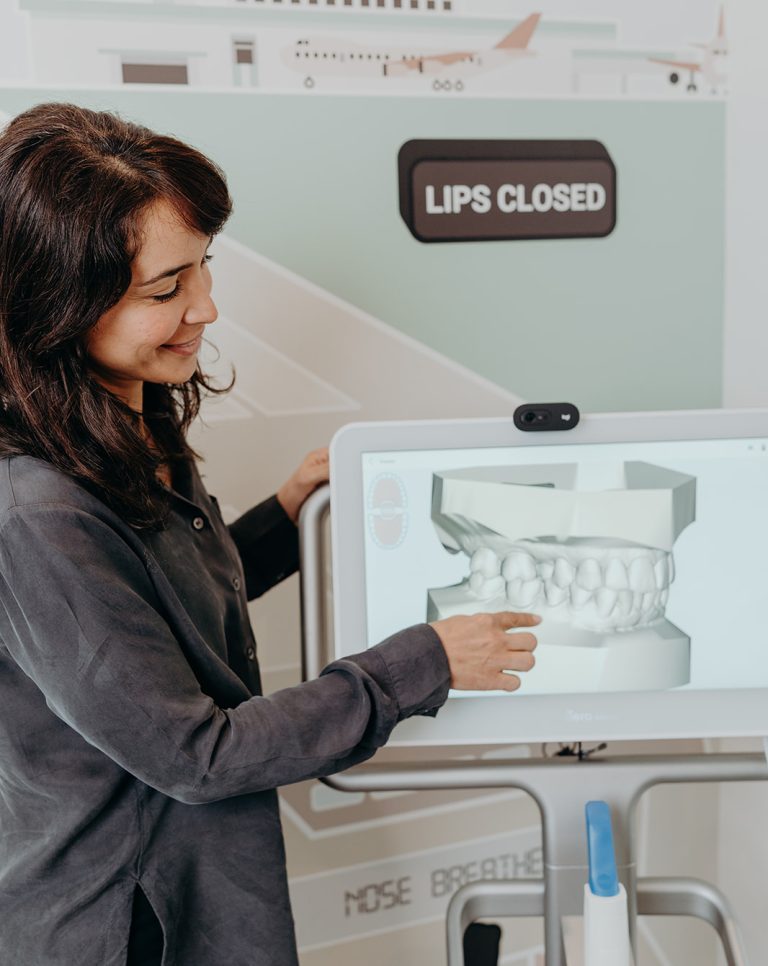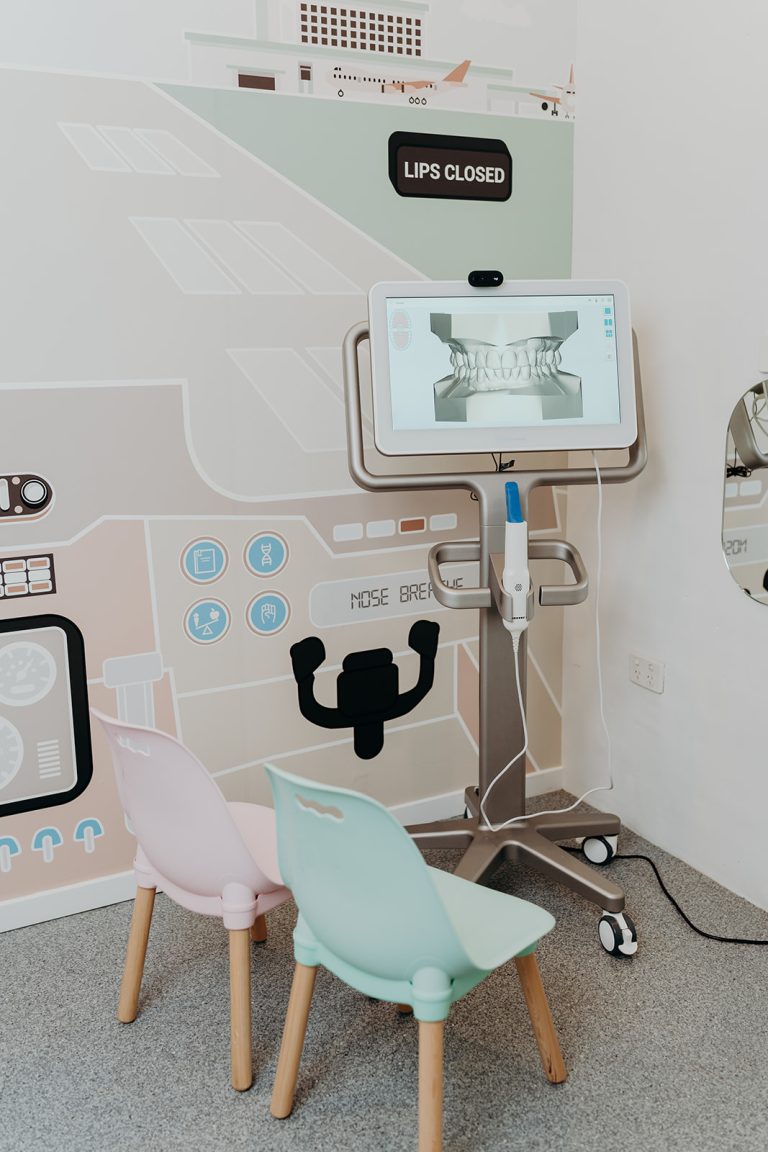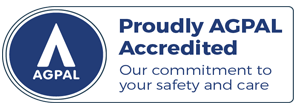
3 TOP RESEARCH BACKED REASONS TO GET YOUR CHILD’S JAW GROWTH CHECKED BEFORE THE ADULT TEETH ERUPT
AND
5 OF THE MOST FREQUENT QUESTIONS ASKED BY PARENTS REGARDING TOOTH AND JAW ALIGNMENT
with Dr Dan Hanson
There are many questions which parents ask regarding the health and development of their children, and it is natural for any parent to want the best for them. Some of those questions are listed below and hopefully this article goes some way towards answering them:
- Why does my child have crooked teeth (a.k.a. ‘malocclusion’)?
- What age is the best age to get them checked?
- Why does my child mouth breathe and is it really a bad thing for them?
- Are crooked teeth just a cosmetic issue or are they a sign of other health problems?
- Is poor sleep related to crooked teeth?
What are the Causes of Malocclusion?
It is widely accepted that the teeth and jaws are at the mercy of the muscles of the lips, cheeks and tongue, and that “soft tissue dysfunction”, or aberrant swallowing (and breathing) patterns are the major cause of malocclusion. (Soft Tissue Dysfunction: a missing clue when treating malocclusions. German O. Ramirez- Yanez, Chris Farrell. International Journal of Functional Orthopedics. 2005). Any factor that leads to either soft tissue dysfunction, or breathing dysfunction, may therefore lead to malocclusion.
Why is it that malocclusion is on the rise?
There is no doubt that malocclusion has risen since more primitive times.
It appears that malocclusion appears to be related to many environmental factors. The fact that wild animals and more isolated populations of human beings do not exhibit much (if any) malocclusion (Weston A Price- Nutrition and Physical Degeneration) indicates that it is likely to be linked to our modern way of life.
It appears that it is a multifactorial syndrome which has come about due to one or more of the following factors (plus other factors that have not been listed) which are all related to our modern ways of living and cultural tendencies.
Essentially, the introduction of anything that leads to aberrant swallowing patterns, poor posture, or dysfunctional breathing will exert some effect on the incidence of malocclusion.

Below are 10 reasons why modern man is more susceptible to aberrant swallowing and dysfunctional breathing:
1. Use of sedatives such as pethidine during labour
Maternal use of any sedative during labour causes effects on the newborn infant. Pethidine half-life is much greater in a neonate than a mother (13 hours compared to 30 minutes). Thus, the infant spends some their first day under the influence of sedation. It has been shown that this influences the infant’s ability to learn to suckle properly and so establishment of proper swallowing (and breathing) patterns becomes difficult.
The first 20 minutes post-partum has been shown to be the most important time to establish proper suckling. Correct or incorrect early suckling patterns were shown to be of prognostic value for the duration and success of breast feeding. ‘Proper’ breast feeding helps to establish proper swallowing patterns. (Lancet 1990; 336: 1105-07. Effect of delivery ward routines on success of first breast feed)
2. Separation from the mother’s skin immediately after birth
The Lancet study named above also showed that separation from the mother’s skin prior to the onset of the first feed negatively affected the infant’s ability to suckle correctly. In fact, the combination of pethidine with separation from the skin had the most deleterious effect.
3. Use of pacifiers during early childhood
Pacifiers (dummies) stop the tongue from learning to elevate into the palate during swallowing and promote incorrect use of the cheek muscles. This causes the infant to learn to swallow in a dysfunctional manner putting unhelpful forces onto the jaws. Therefore, increased use of pacifiers would lead to increased malocclusion (see causes of malocclusion).
4. Use of bottles during feeding
Bottles have a similar effect to pacifiers; in that they have the potential to alter normal swallowing patterns. Bottles do provide nutrition so could be argued to be better than pacifiers. Nonetheless, they still create aberrant swallowing patterns which deform the developing jaws.
5. Mothers being too tired to feed infants
It is not uncommon in our modern world for our mother’s to be managing multiple commitments. Modern mothers often take on more than just mothering and have to run the home as well as a business, or full-time job. Mothers are likely to be more tired than they used to be, and many tell stories of having to breast feed while they are half asleep and feeling incredibly stressed. At times tiredness from modern pressures makes them get sick or have difficulties with lactation. Inevitably these pressures will lead to the infant being bottle fed rather than exclusively breast fed.
6. Soft, sloppy and refined diets
When vets tell us to give bones to our puppies so they can develop proper masticatory muscles and grow strong jaws they are giving us sound advice. Compare this to the common foods eaten by young babies, and it’s clear to see that we typically feed our young soft foods, that are often sucked than chewed.
Primitive populations had a harder diet compared to the sloppy nutritionally devoid foods that we often feed our modern babies, and this allowed more primitive populations to develop proper swallowing patterns and stronger masticatory muscles, which in turn led to well-formed jaws. (Weston A Price – Nutrition and Physical Degeneration)
7. Poor nutritional content of modern foods and resulting intolerances and inflammation
Prior to refrigeration, and preservatives, foods were mostly fresh, seasonal, and diverse. Nowadays, foods can be months, or even years old by the time we eat them. Furthermore, the food industry has altered our food sources to enable longer shelf life and higher yield. Whilst this has its advantages, it certainly comes with a health warning. One example of such a modification is in cow’s milk. There is a substantial body of evidence to support theories that proteins such as casein in milk may be major causes of allergy and congestion. Consumption of high volumes of cow’s milk products is a modern phenomenon. Propaganda relating to its benefits is supported by the huge marketing budgets of the dairy industry, and it is worth considering that we are the only species that drinks milk after infancy, and certainly the only species that drinks the milk of another species. (Hill et al Clinical Manifestation of cow’s milk allergy in childhood the diagnostic value of skin tests and RAST Clinical allergy 1988; 18; 481-490.) (Stricker T et al Constipation and intolerance to cow’s milk J Paed Gastroenterology and nutrition 2000;30;224)
The fact is that a food that has been refined in any way, has a greater chance of having poor nutritional content, than a completely fresh, seasonal, chemical free version. Moreover, the lack of diversity in our diet puts us at further risk of being over-fed but undernourished. This malnourishment is linked to an increased frequency of illnesses. In 10 years from 2001 to 2011, there was a fivefold increase in anaphylaxis from food allergy. (J Allergy Clin Immunol 2011 127:688-76)
However, illnesses may range from the common cold, to ADHD, to congestion and diabetes. Since illness often leads to a blocked nose and open mouth posture, it goes without saying that it may lead to malocclusion since mouth breathing relates to a low tongue posture. A child who is often sick with a blocked nose, and open mouth posture will be more likely to exhibit a vertical growth pattern (long face and gummy smile). The tongue is supposed to be free to sit up high in the palate and stimulate proper growth of the maxilla. Mouth breathing due to habit, sickness, or congestion leads to low tongue posture, so the tongue does not properly drive the growth of the upper jaw.
8. Habits that lead to poor posture
Modern children are future chiropractic time bombs. Poor posture is a major symptom of a comfortable and sedentary lifestyle. Watching TV or playing on computer games, or smart phones whilst sitting on a beautiful soft leather sofa might be fun. However, it is a recipe for poor core strength, a subluxation of the neck and resultant poor posture. Since posture affects breathing patterns and growth direction, it is likely to affect malocclusion formation. In addition, the growth of the eye sockets and ears which both sit on the upper jaw will become asymmetrical if the head is not straight since the optic and otic planes will grow in line with the horizon. A head-tilt will fool this system into uneven growth. The message here is to sit or stand up straight more often.
9. Increased stimulation leading to illness
Modern humans are over stimulated compared to their more primitive counterparts. Exposure to screen technology past the hours of darkness, such as TVs and I-pads may lead to poor sleep due to suppression of the sleep hormone melatonin. (Lighting Research Center at Rensselaer Polytechnic Institute)
Good quality sleep is linked to better health. Better health is linked to less congestion and nose breathing and therefore less malocclusion.
10. Increased sympathetic nervous system activity and increased respiratory drive (mouth breathing)
All the above have the potential to excite the “fight or flight” sympathetic autonomic nervous system. Prolonged and frequent excitation of this is likely to lead to increases in breathing dysfunction since increased respiration occurs during such events.
This increased respiratory drive on a frequent basis may lock the child into a pattern of “over-breathing” or “habitual hyperventilation.” When this happens the Minute Volume (volume of air breathed per minute) at rest increases. Once this becomes the norm, an open mouth posture and habitual mouth breathing occurs to allow the bigger volume of air to be breathed. Open mouth posture and low tongue posture affects craniofacial growth and jaw development.
Prevalence of malocclusion among mouth breathing children: do expectations meet reality? Souki BQ, Pimenta GB, Souki MQ, Franco LP, Becker HM, Pinto JA, Federal University of Minas Gerais, Outpatient Clinic for Mouth-Breathers, Belo Horizonte, Brazil. Int J Pediatr Otorhinolaryngol. 2009 May; 73(5): p.767- 773.
Etiology, clinical manifestations and concurrent findings in mouth-breathing children. Abreu RR, Rocha RL, Lamounier JA, Guerra AF. J Pediatr (Rio J). 2008 Nov-Dec; 84(6): p.529-535.
Radiological evaluation of facial types in mouth breathing children: a retrospective study. Costa JR, Pereira SR, Weckx LL, Pignatari SN, Uema SF. Int J Orthod Milwaukee. 2008 Winter; 19(4): p. 13-16.

Why is there a need for an effective early interventional approach?
Here are 3 top research backed reasons to intervene early:
Reason 1:
Less than ideal facial growth and development is highly related to snoring and sleep apnoea in children and throughout life.
Paediatric obstructive sleep apnoea and the critical role of orofacial growth: evidences – Yu Shu Huang and Christian Guilleminault – Frontiers in Neurology, January 2013.
Reason 2:
Poor sleep reduces the chance of doing well at school and increases the likelihood of behavioural problems, and hyperactivity.
Sleep disordered breathing in a population-based cohort: Behavioural outcoems at 4 and 7 years. Paediatrics, Vol 129 Number 4, April 2012
Reason 3:
Kids are often bullied at school due to poor facial growth, whether it’s ‘buck teeth’ or cross-bites, these appearances can become targets for bullies.
Bullying among Jordanian school children, its effects on school performance, and the contribution of general physical and dentofacial features. AJODO: Dec 2013, Vol 144, Issue 6, P872-878
Malocclusion is not just about the teeth. The teeth are simply a symptom of an overall “syndrome” and are merely the tip of a very large iceberg. Jaw growth occurs throughout childhood with most of the growth being completed before the permanent dentition is fully erupted.
Achieving close to the maximum genetic potential for growth of the maxilla and mandible are not just important for straight teeth. These bones make up parts of the face and are gateways to the airway.
Waiting for all the teeth to erupt until age 12 or 13 is condemning the child to a face that is potentially less symmetrical, and an airway that is potentially smaller than it might otherwise have been. For these reasons alone, it makes no sense to isolate the problem to the teeth, and only act in the best interests of straight teeth. It’s like building houses on land that isn’t large enough, or not even. The houses are the teeth, and the land is the jaws.
Previously, “phase 1 pre-orthodontics” has been rejected by some due to the potential for relapse while waiting for the final eruption of the permanent dentition. However, many of the systems used for phase 1 have not focused on changing the muscle patterns (myofunction) at the same time as expanding the jaws and aligning the teeth. A better system would involve both correction of myofunctional causes, and active expansion and alignment where necessary. Or better still, in the case of an oral restrictions such as a tongue tie, early correction using an inter-disciplinary approach.
The fact that malocclusion is more than just crooked teeth, suggests that a system which works on all aetiological factors and co-morbidities of malocclusion is preferential. Therefore, involvement of a team of professionals working to establish proper function is a better approach. This team may involve the following professions:
- Dentist or orthodontist to diagnose the condition and expand the jaws to make space
- Dentist or orthodontist to monitor treatment progress and to prescribe the treatment plan
- Oral Myofunctional therapist to help train the muscles (lips, cheeks and tongue) to function normally
- Bodyworker (cranial chiropractor or cranial osteopath) to assist with musculoskeletal compensatory co-morbidities such as altered neck posture
- Breathing educator to assist with correction of habitual hyperventilation and establish proper breathing patterns
- Allergist to identify causes of congestion and decide on management of such
- ENT to assess whether management of enlarged adenoids and tonsils is necessary
- Speech and language pathologist if the malocclusion has led to speech difficulties (more likely when there is a tongue tie or open bite present)

So, what should be done if malocclusion is suspected?
Early diagnosis and intervention are essential for complete treatment, so refer to a dentist or orthodontist who focusses on “Pre-Orthodontics”. Not all practitioners are the same and often have different training with exposure to different philosophies and modalities. Given that malocclusion is linked to dysfunctional swallowing and breathing patterns and given that it is not just a problem for the teeth – it’s a growth disorder – referral to a dentist or orthodontist who focusses on establishing proper growth as early as possible is essential.
How can malocclusion be reduced or prevented?
- Do everything possible to establish functional breast feeding from day 1 of life. If there is a tongue or lip tie get it diagnosed immediately and treated as early as possible. It is functional breast feeding which leads to functional swallowing and breathing patterns. See a qualified IBCLC to help with this, and if tongue tie surgery is needed be sure to use a multi-disciplinary approach to care (dentist / oral surgeon, IBCLC and bodyworker). Ensure a thorough surgery is carried out by an experienced tongue tie focussed surgeon.
- Avoid non-nutritive sucking habits such as pacifiers. These create dysfunctional swallowing patterns.
- Avoid use of bottle feeding if possible. Bottles also create dysfunctional swallowing patterns leading to malocclusion. In our modern society where mums often must go to work this can be very difficult. However, when it is an option, avoid bottle feeding.
- Introduce healthy, fresh, seasonal non-refined solid foods to your infant when the baby teeth emerge. These foods encourage proper chewing patterns. Avoid the sloppy refined foods.
- Promote proper core strength. Ensure plenty of ‘tummy-time’ – aim for 30 minutes a day by 4 months of age.
- Encourage healthy play outdoors and do not allow your child to use tablets excessively or sit in car seats for long periods of time as unhealthy posture will result.
- No screens after dark. This is to assist with proper sleeping patterns.
- Get the jaw growth and tooth eruption checked by a Pre-Orthodontic Myofunctioonal practitioner by 5 years of age.

Dr Dan Hanson BDS, MBIBH
Dr Dan is co-founder of Myofocus Australia Pty Ltd, a company which offers myofunctional education to dentists, orthodontists, dental hygienists, osteopaths, chiropractors, speech therapists and other allied health professionals.
Dr Dan is currently based at The Health Lodge in Byron Bay where he runs ’The Myofunctional Space’ with Dr Mona Board – to learn more click here
To make an appointment for a consultation for your child please call the clinic (02) 6685 6445
For more information about ‘The Myofunctional Space’ visit their website here

